Sharded Matrices and How to Multiply Them
Part 3 of How To Scale Your Model (Part 2: TPUs | Part 4: Transformer Math)
여기서는 가장 큰 ML 모델들이 어떻게 여러 가속기에 걸쳐 분할(또는 '샤딩(sharded)')되는지 설명합니다. LLM은 대부분 행렬 곱셈으로 이루어져 있으므로, 이를 이해하는 것은 결국 행렬이 여러 디바이스에 분할되어 있을 때 어떻게 곱하는지를 이해하는 것으로 귀결됩니다. 저희는 TPU 통신 기본 연산(primitive)의 비용에 기반한 샤딩된 행렬 곱셈의 간단한 이론을 개발합니다.
번역 안내: 원저자(Jacob Austin)의 허락을 받아 원문을 번역 중입니다.
해당 글의 1인칭은 원문 저자를 지칭합니다.
원문: How to Scale Your Model
번역: 신종훈
Partitioning Notation and Collective Operations
수만 개의 TPU에서 LLM을 훈련할 때도, 추상적으로는 하나의 TPU에서 훈련할 때와 동일한 계산을 수행합니다. 차이점은 우리의 배열이 단일 TPU의 HBM에 들어가지 않아서 분할해야 한다는 것입니다.
다음은 4개의 TPU에 걸쳐 샤딩된 2D 배열 A의 예입니다:
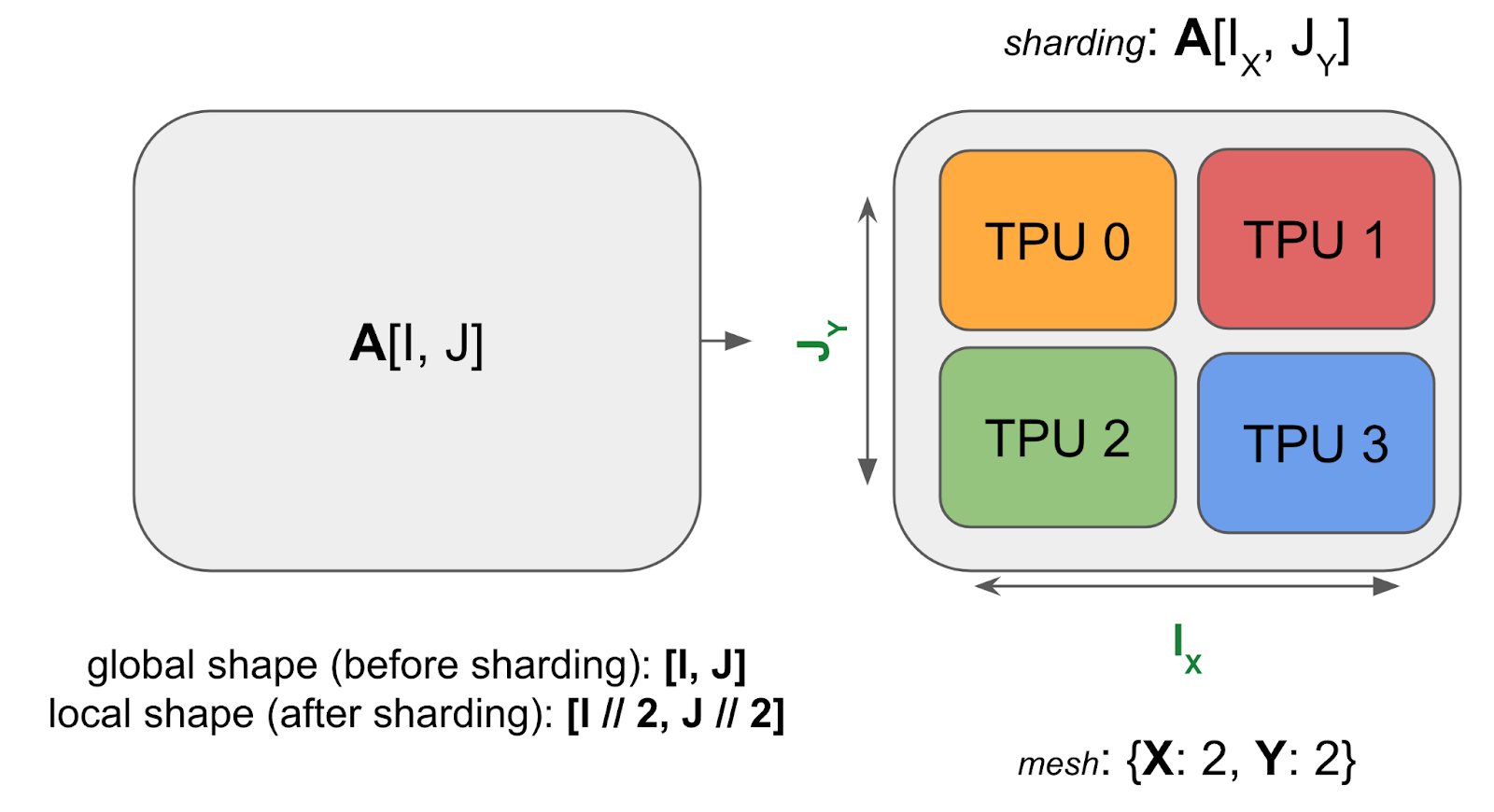
샤딩된 배열은 여전히 샤딩되지 않은 배열과 동일한 전역(global) 또는 논리적 형태(logical shape)(예: (4, 128))를 가지지만, (2, 64)와 같은 디바이스 로컬 형태(device local shape)도 가집니다. 이는 각 TPU가 실제로 보유하고 있는 바이트 단위의 크기를 알려줍니다(위 그림에서 각 TPU는 전체 배열의 ¼을 보유함). 이제 이를 임의의 배열로 일반화해 보겠습니다.
A unified notation for sharding
우리는 텐서가 디바이스에 걸쳐 블록으로 어떻게 샤딩되는지를 설명하기 위해 named-axis notation의 변형을 사용합니다: X, Y, Z와 같이 메시 축 이름(mesh axis names)이 부여된 2D 또는 3D 디바이스 그리드인 디바이스 메시(device mesh)가 있다고 가정합니다. 그런 다음 배열의 각 이름 있는 차원이 물리적 메시 축에 걸쳐 어떻게 분할되는지를 설명함으로써 행렬 데이터가 디바이스 메시에 어떻게 배치되는지를 지정할 수 있습니다. 우리는 이 할당을 샤딩(sharding)이라고 부릅니다.
예제 (위 다이어그램): 위 다이어그램의 경우, 다음과 같습니다:
- Sharding: $A[I_X, J_Y]$, 이는 첫 번째 축 $I$를 메시 축 $X$를 따라 샤딩하고, 두 번째 축 $J$를 메시 축 $Y$를 따라 샤딩하라는 것을 알려줍니다. 이 샤딩은 각 샤드가 배열의 $1 / (\lvert X\rvert \cdot \lvert Y\rvert)$ 를 보유함을 알려줍니다.
- Mesh: 위 디바이스 메시
Mesh(devices=((0, 1), (2, 3)), axis_names=(‘X', ‘Y'))는 4개의 TPU가 2x2 그리드에 있으며, 축 이름이 $X$와 $Y$임을 알려줍니다.
이 둘을 종합하면, 배열의 로컬 형태(개별 디바이스가 보유하는 샤드의 크기)는 $(\lvert I\rvert / 2, \lvert J\rvert / 2)$ 임을 알 수 있습니다. 여기서 \(\lvert I\rvert\) 는 A의 첫 번째 차원 크기이고 \(\lvert J\rvert\) 는 A의 두 번째 차원 크기입니다.
Example (1개 축에 대한 2D 샤딩): $A[I_{XY}, J]$ 는 첫 번째 차원(I)을 X와 Y 하드웨어 축 모두에 걸쳐 샤딩합니다. 디바이스당 바이트 수는 이전 샤딩과 동일하지만 로컬 형태는 다릅니다. 이제 $(\lvert I\rvert /(\lvert X\rvert \cdot \lvert Y\rvert), \lvert J\rvert)$ 입니다.
Visualizing these shardings: 4개의 디바이스에 분할된 2D 데이터 배열을 보며 이러한 샤딩을 시각화해 봅시다:
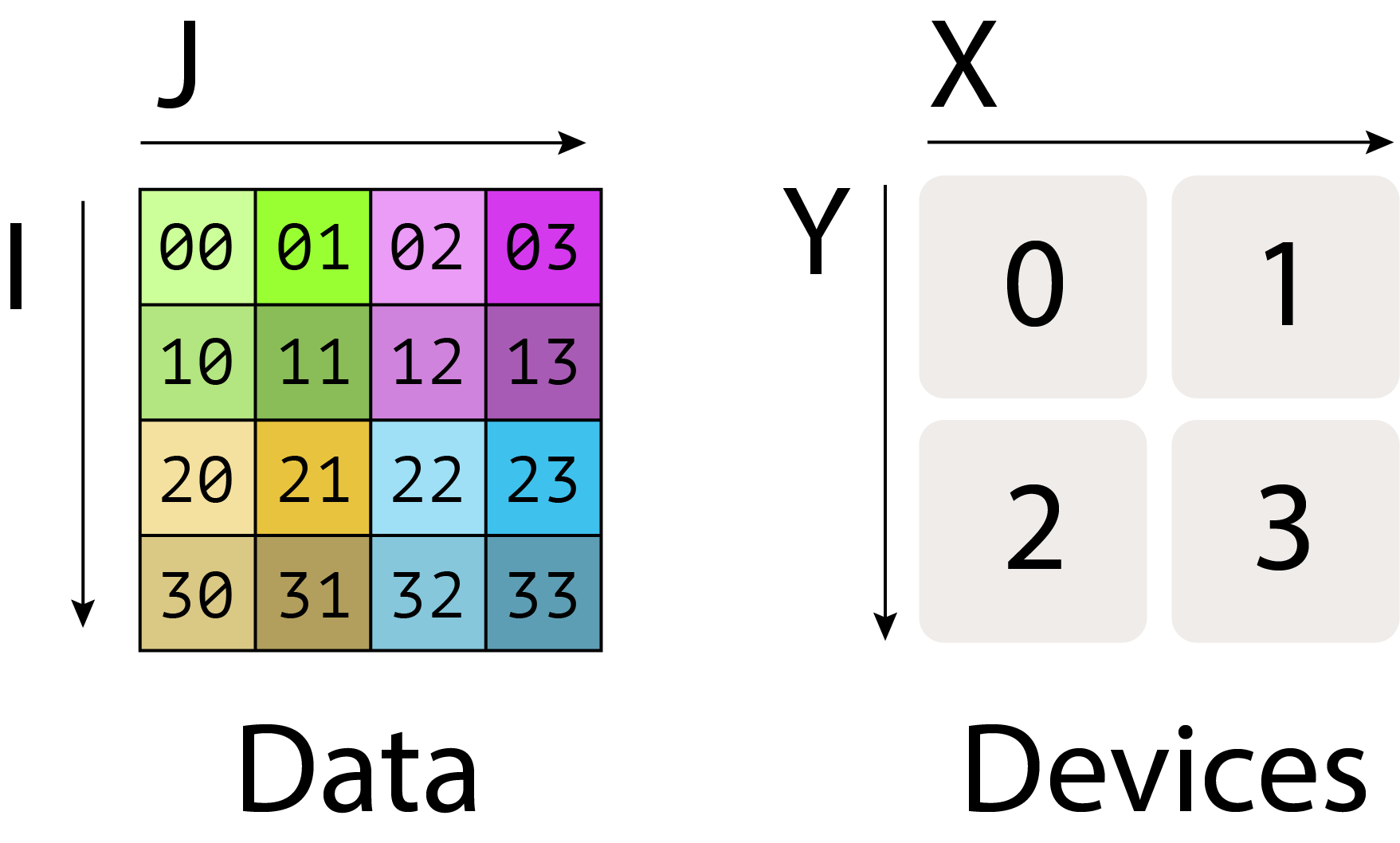
행렬의 완전 복제(fully-replicated) 형태는 샤딩 할당 없이 단순히 $A[I, J]$로 씁니다. 이는 각 디바이스가 전체 행렬의 완전한 복사본을 포함함을 의미합니다.
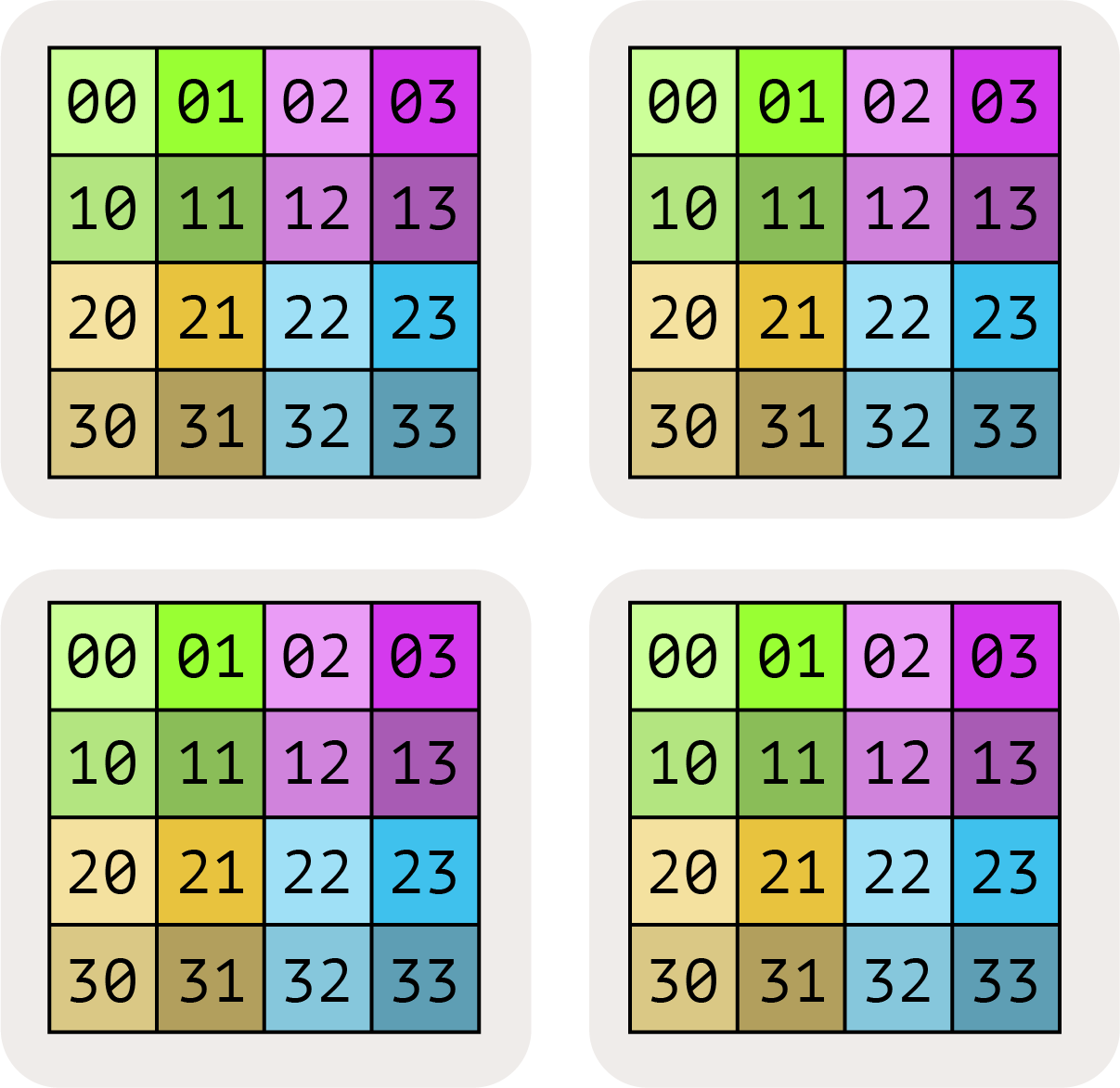
이러한 차원 중 하나가 메시 축에 걸쳐 분할되었음을 나타내고 싶을 때는 메시 축 아래 첨자를 사용합니다. 예를 들어 $A[I_X, J]$는 I 논리적 축이 X 메시 차원에 걸쳐 분할되었지만, J 차원은 분할되지 않았으며, 블록이 Y 메시 축에 걸쳐 부분적으로 복제(partially-replicated)되어 있음을 의미합니다.
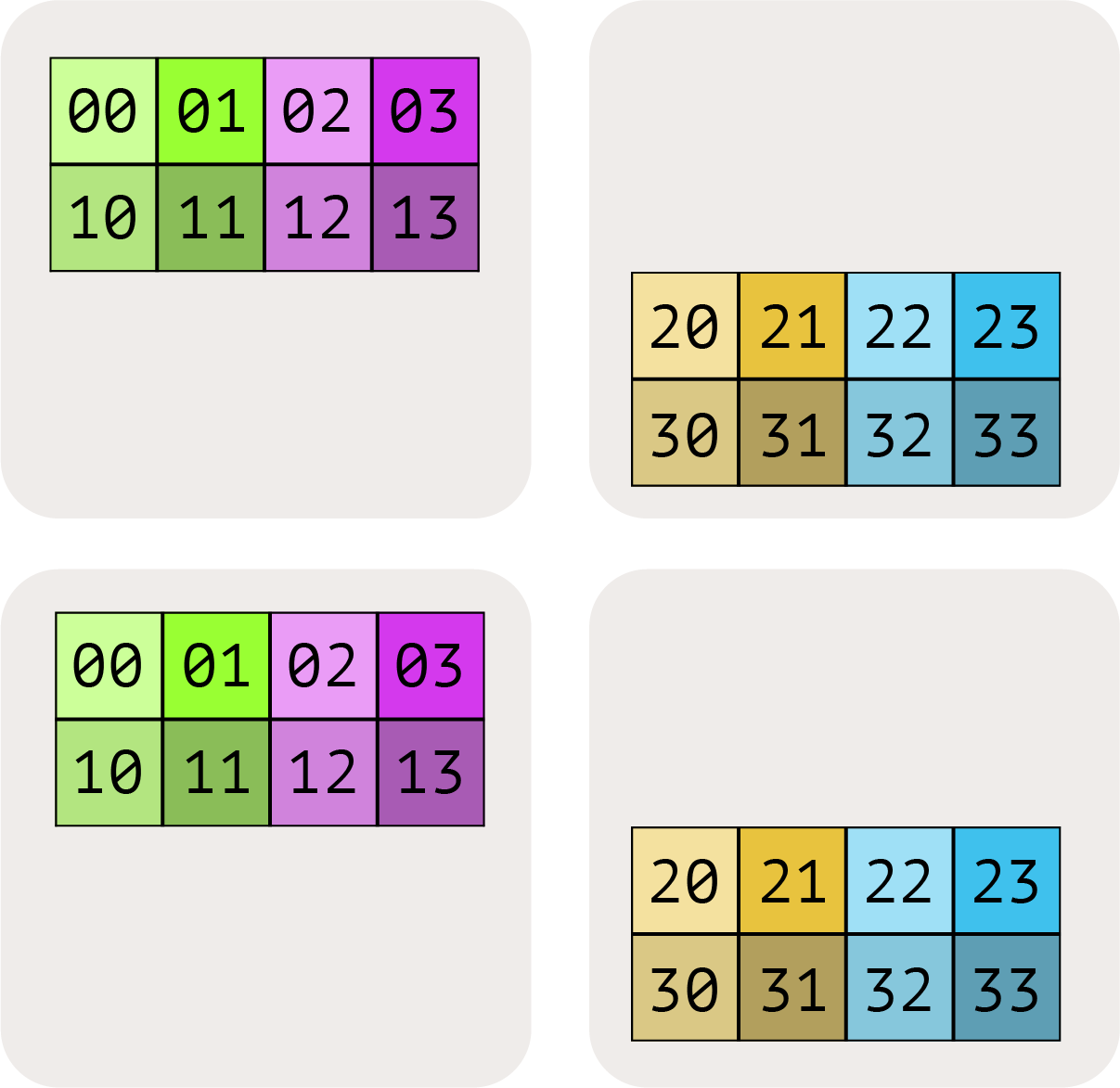
$A[I_X, J_Y]$ 는 I 논리적 축이 X 메시 축에 걸쳐 분할되었고, J 차원이 Y 메시 축에 걸쳐 분할되었음을 의미합니다.
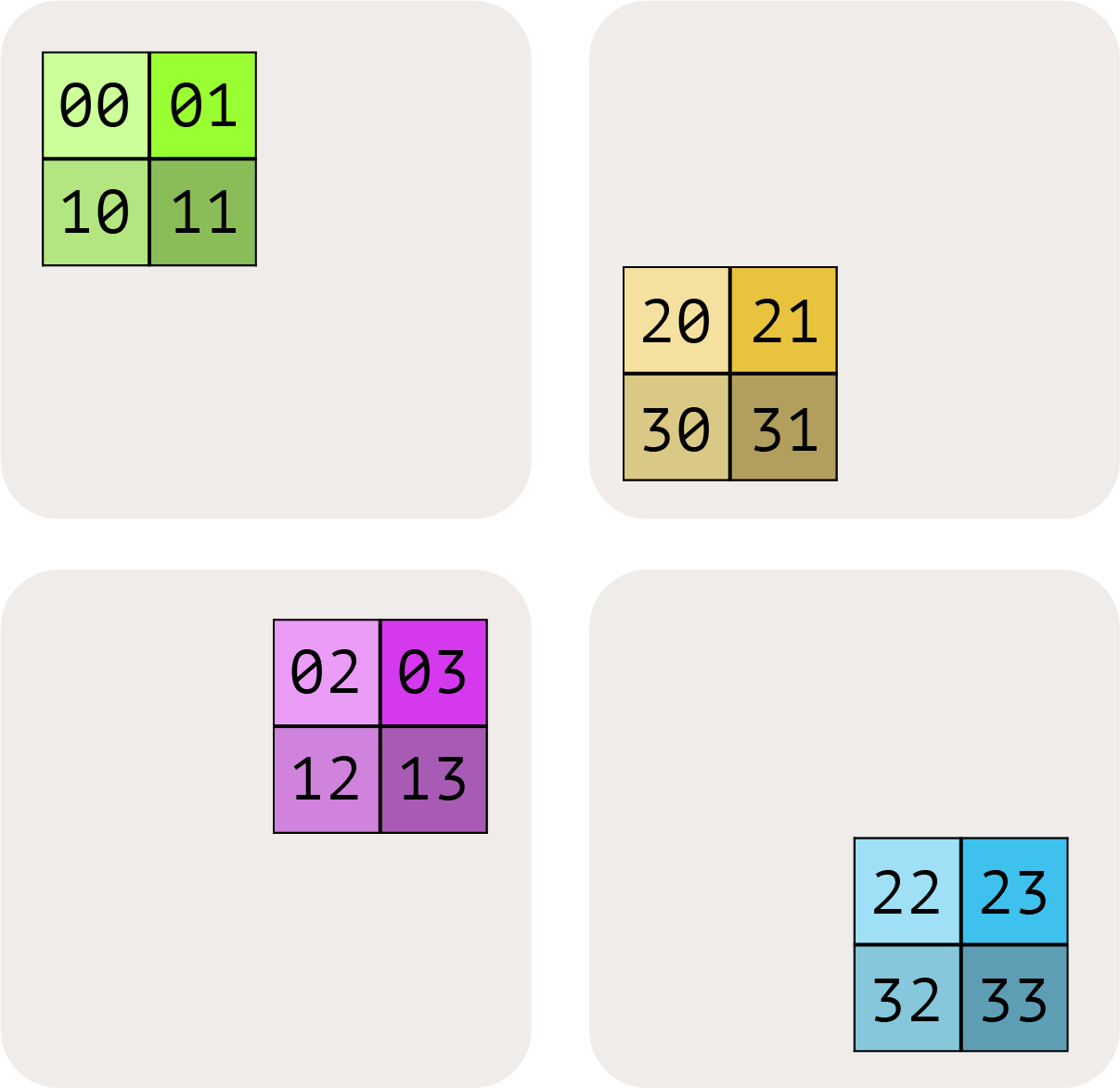
아래 그림에서 다른 가능성들을 보여줍니다:

여기서 $A[I_{XY}, J]$ 는 X와 Y 메시 축을 더 큰 평탄화된 차원으로 취급하고, I 이름 있는 축을 모든 디바이스에 걸쳐 분할함을 의미합니다. 여러 메시 축 아래 첨자의 순서는 그리드에 걸친 분할(partitioning)의 순회 순서(traversal order)를 지정하므로 중요합니다.
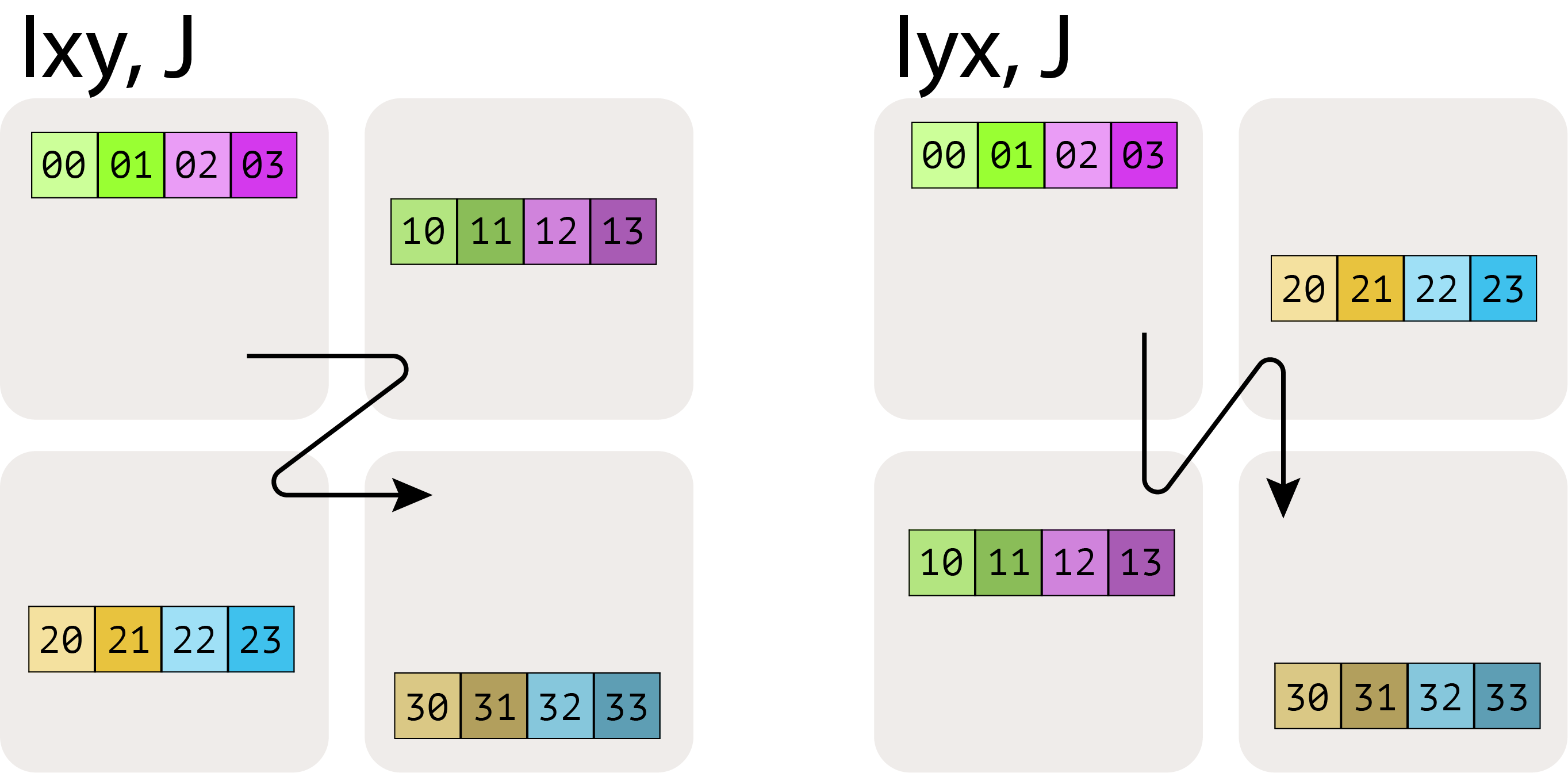
마지막으로, 여러 이름 있는 축이 동일한 메시 차원을 따라 샤딩될 수 없다는 점에 유의하세요. 예를 들어 $A[I_X, J_X]$는 의미가 없는 금지된 샤딩입니다. 메시 차원이 배열의 한 차원을 샤딩하는 데 사용되면, 그것은 일종의 “소진된” 상태가 됩니다.
Pop Quiz: A가 int8[128, 2048] 형태의 배열이고, 샤딩이 $A[I_{XY}, J]$이며, 메시가 Mesh({‘X': 2, ‘Y': 8, ‘Z': 2})(총 32개 디바이스)라고 가정한다면, A는 디바이스당 얼마나 많은 메모리를 사용할까요? 모든 디바이스에 걸쳐 총 얼마나 많은 메모리를 사용할까요?
답을 보려면 여기를 클릭하세요.
Answer: 배열 A는 X와 Y에 걸쳐 샤딩되고 Z에 걸쳐 복제되므로, 디바이스당 형태는 int8[128 / (2 * 8), 2048] = int8[8, 2048]이며, 크기는 8 * 2048 = 16,384 바이트입니다. Z에 걸쳐 복제되므로, X와 Y에 걸쳐 완전히 샤딩된 Z-평면마다 복사본이 하나씩 있고, 그런 평면이 2개 있으므로, 총 크기(모든 디바이스에 걸쳐)는 128 * 2048 * 2 = 512kiB입니다.
A quick aside: how would we describe this in code?
JAX는 위에서 설명한 추상적인 구문과 매우 유사한 이름 있는 샤딩 구문을 사용합니다. 이에 대해서는 섹션 10에서 더 자세히 이야기하겠지만, 간단히 미리 살펴보겠습니다. You can play with this in a Google Colab 여기 에서 이것을 직접 실행해보고 결과를 프로파일링하여 JAX가 다른 샤딩을 어떻게 처리하는지 볼 수 있습니다. 이 스니펫은 3가지 작업을 수행합니다:
- 8개의 TPU를 ‘X’와 ‘Y’라는 이름이 할당된 두 축을 가진 4x2 그리드로 매핑하는 jax.Mesh를 생성합니다.
- 행렬 A와 B를 생성하는데, A는 두 차원 모두에 걸쳐 샤딩되고 B는 출력 차원을 따라 샤딩됩니다.
- 샤딩된 배열을 반환하는 간단한 행렬 곱셈을 컴파일하고 수행합니다.
import jax
import jax.numpy as jnp
import jax.sharding as shd
# Create our mesh! We're running on a TPU v2-8 4x2 slice with names 'X' and 'Y'.
assert len(jax.devices()) == 8
mesh = jax.make_mesh(axis_shapes=(4, 2), axis_names=('X', 'Y'))
# A little utility function to help define our sharding. A PartitionSpec is our
# sharding (a mapping from axes to names).
def P(*args):
return shd.NamedSharding(mesh, shd.PartitionSpec(*args))
# We shard both A and B over the non-contracting dimension and A over the contracting dim.
A = jnp.zeros((8, 2048), dtype=jnp.bfloat16, device=P('X', 'Y'))
B = jnp.zeros((2048, 8192), dtype=jnp.bfloat16, device=P(None, 'Y'))
# We can perform a matmul on these sharded arrays! out_shardings tells us how we want
# the output to be sharded. JAX/XLA handles the rest of the sharding for us.
compiled = jax.jit(lambda A, B: jnp.einsum('BD,DF->BF', A, B), out_shardings=P('X', 'Y')).lower(A, B).compile()
y = compiled(A, B)
JAX의 멋진 점은 이 배열들이 샤딩되지 않은 것처럼 동작한다는 것입니다! B.shape는 전역 또는 논리적 형태(2048, 8192)를 알려줄 것입니다. 로컬로 어떻게 샤딩되었는지 보려면 B.addressable_shards를 실제로 봐야 합니다. 이 배열들에 대해 연산을 수행하면 JAX는 연산을 수행하기 위해 어떻게 브로드캐스트하거나 재구성할지 알아서 처리합니다. 예를 들어, 위 예에서 A의 로컬 형태는 [2, 1024]이고 B의 로컬 형태는 [2048, 4096]입니다. JAX/XLA는 최종 곱셈을 수행하기 위해 필요에 따라 이 배열들 간의 통신을 자동으로 추가합니다.
Computation With Sharded Arrays
여러 디바이스에 분산된 데이터 배열이 있고 이에 대해 수학적 연산을 수행하고자 할 때, 데이터와 계산을 모두 샤딩하는 데 관련된 오버헤드는 무엇일까요?
당연히, 이것은 관련된 계산에 따라 다릅니다.
- 원소별(elementwise) 연산의 경우, 분산된 배열에 대해 연산하는 데 오버헤드가 없습니다.
- 여러 디바이스에 상주하는 원소들에 걸쳐 연산을 수행하고자 할 때, 상황은 복잡해집니다. 다행히도, 대부분의 머신러닝에서 거의 모든 계산은 행렬 곱셈 형태로 이루어지며, 이는 비교적 간단하게 분석할 수 있습니다.
이 섹션의 나머지 부분에서는 샤딩된 행렬을 곱하는 방법을 다룹니다. 대략적으로 말해, 이것은 각 청크를 완전히 곱하거나 합산할 수 있도록 행렬의 청크를 이동시키는 것을 포함합니다. 각 샤딩은 다른 통신을 포함합니다. 예를 들어, $A[I_X, J] \cdot B[J, K_Y] \to C[I_X, K_Y]$는 축소 차원(실제로 합산하는 차원인 J)이 샤딩되지 않았기 때문에 통신 없이 곱셈이 가능합니다. 하지만 출력이 샤딩되지 않기를 원한다면(즉, $A[I_X, J] \cdot B[J, K_Y] \to C[I, K]$), $A$ 또는 $C$를 모든 디바이스에 복사해야 합니다. 이 두 가지 선택은 다른 통신 비용을 가지므로, 이 비용을 계산하고 가장 낮은 것을 선택해야 합니다.
이를 “블록 행렬 곱셈”으로 생각할 수 있습니다.
먼저 “블록 행렬”, 즉 행렬의 중첩된 행렬 개념을 상기해 봅시다:
\[\begin{equation} \begin{pmatrix} a_{00} & a_{01} & a_{02} & a_{03} \\ a_{10} & a_{11} & a_{12} & a_{13} \\ a_{20} & a_{21} & a_{22} & a_{23} \\ a_{30} & a_{31} & a_{32} & a_{33} \end{pmatrix} = \left( \begin{matrix} \begin{bmatrix} a_{00} & a_{01} \\ a_{10} & a_{11} \end{bmatrix} \\ \begin{bmatrix} a_{20} & a_{21} \\ a_{30} & a_{31} \end{bmatrix} \end{matrix} \begin{matrix} \begin{bmatrix} a_{02} & a_{03} \\ a_{12} & a_{13} \end{bmatrix} \\ \begin{bmatrix} a_{22} & a_{23} \\ a_{32} & a_{33} \end{bmatrix} \end{matrix} \right) = \begin{pmatrix} \mathbf{A_{00}} & \mathbf{A_{01}} \\ \mathbf{A_{10}} & \mathbf{A_{11}} \end{pmatrix} \end{equation}\]행렬 곱셈은 피곱셈 행렬이 블록으로 작성될 때, 곱이 표준 규칙에 따라 블록 행렬 곱셈으로 작성될 수 있다는 좋은 속성을 가집니다:
\[\begin{equation} \begin{pmatrix} A_{00} & A_{01} \\ A_{10} & A_{11} \end{pmatrix} \cdot \begin{pmatrix} B_{00} & B_{01} \\ B_{10} & B_{11} \end{pmatrix} = \begin{pmatrix} A_{00}B_{00} + A_{01}B_{10} & A_{00}B_{01} + A_{01}B_{11} \\ A_{10}B_{00} + A_{11}B_{10} & A_{10}B_{01} + A_{11}B_{11} \end{pmatrix} \end{equation}\]이것이 의미하는 바는, 분산 행렬 곱셈을 구현하는 것은 이 샤딩된 블록들을 네트워크를 통해 이동시키고, 블록에 대해 로컬 행렬 곱셈을 수행하고, 그 결과를 합산하는 것으로 귀결된다는 것입니다. 문제는 어떤 통신을 추가하고, 그것이 얼마나 비싼가입니다.
편리하게도, 모든 가능한 샤딩을 우리가 고려해야 할 대략 4가지 경우로 요약할 수 있으며, 각각은 어떤 통신을 추가해야 하는지에 대한 규칙을 가집니다.
- Case 1: 어느 피곱셈 행렬도 축소 차원이 샤딩되지 않음. 통신 없이 로컬 샤드를 곱할 수 있습니다.
- Case 2: 한 피곱셈 행렬에 샤딩된 축소 차원이 있음. 일반적으로 축소 차원을 따라 샤딩된 입력을 “AllGather”합니다.
- Case 3: 두 피곱셈 행렬 모두에 샤딩된 축소 차원이 있음. 로컬 샤드를 곱한 다음, 결과를 “AllReduce”할 수 있습니다.
- Case 4: 두 피곱셈 행렬 모두 동일한 축을 따라 샤딩된 비축소 차원을 가짐. 두 입력 중 하나를 먼저 AllGather하지 않고는 진행할 수 없습니다.
이것들을 단순히 따라야 할 규칙으로 생각할 수도 있지만, 이 규칙들이 왜 성립하고 얼마나 비싼지를 이해하는 것도 가치가 있습니다. 이제 각각을 자세히 살펴보겠습니다.
Case 1: 어느 피곱셈 행렬도 샤딩된 축소 차원을 가지지 않음
Lemma: 분할된 텐서를 곱할 때, 계산은 유효하며 출력은 입력의 샤딩을 따릅니다. 단, 축소 차원이 샤딩되거나 두 텐서 모두 동일한 축을 따라 샤딩된 비축소 차원을 가지는 경우는 예외입니다. 예를 들어, 다음은 잘 작동합니다.
\[\begin{equation*} \mathbf{A}[I_X, J] \cdot \mathbf{B}[J, K_Y] \rightarrow \mathbf{C}[I_X, K_Y] \end{equation*}\]전혀 통신 없이, 그리고 결과는 X와 Y 하드웨어 차원 모두에 걸쳐 샤딩된 텐서가 됩니다. 왜 그런지 생각해보세요. 기본적으로, 계산은 샤딩과 독립적입니다. 왜냐하면 각 배치 항목은 곱하고 축소할 수 있는 축소 중인 축의 로컬 청크를 가지고 있기 때문입니다. 다음 사례들 중 어떤 것이든 잘 작동하며 이 규칙을 따릅니다:
\[\begin{align*} \mathbf{A}[I, J] \cdot \mathbf{B}[J, K] \rightarrow &\ \mathbf{C}[I, K] \\ \mathbf{A}[I_X, J] \cdot \mathbf{B}[J, K] \rightarrow &\ \mathbf{C}[I_X, K]\\ \mathbf{A}[I, J] \cdot \mathbf{B}[J, K_Y] \rightarrow &\ \mathbf{C}[I, K_Y]\\ \mathbf{A}[I_X, J] \cdot \mathbf{B}[J, K_Y] \rightarrow &\ \mathbf{C}[I_X, K_Y] \end{align*}\]A나 B 모두 샤딩된 축소 차원 J를 가지지 않으므로, 입력의 로컬 블록 행렬 곱셈을 수행하기만 하면 결과는 이미 원하는 출력 샤딩에 따라 샤딩되어 있습니다. 두 피곱셈 행렬 모두 동일한 축을 따라 샤딩된 비축소 차원을 가질 때는 이것이 더 이상 사실이 아닙니다(invalid shardings(유효하지 않은 샤딩) 섹션 참조).
Case 2: 한 피곱셈 행렬이 샤딩된 축소 차원을 가짐
축소 J 차원에서 샤딩된 A와 완전 복제된 B의 분산 행렬 곱셈의 간단한 경우를 고려해 봅시다:
\[\mathbf{A}[I, J_X] \cdot \mathbf{B}[J, K] \rightarrow \mathbf{C}[I, K]\]로컬 A, B 블록을 서로 곱하는 로컬 행렬 곱셈을 단순히 수행할 수 없습니다. A의 축소 축에서 전체 데이터가 없기 때문입니다. 일반적으로, 먼저 A의 샤드를 로컬에서 “AllGather“한 다음, B와 곱합니다:
\[\textbf{AllGather}_X[I, J_X] \rightarrow \mathbf{A}[I, J]\] \[\mathbf{A}[I, J] \cdot \mathbf{B}[J, K] \rightarrow \mathbf{C}[I, K]\]AllGather는 축을 따라 샤딩을 제거하고 디바이스에 걸쳐 퍼져 있는 샤드를 해당 축을 따라 각 디바이스에 재조립합니다. 위 표기법을 사용하면, AllGather는 축 집합에서 아래 첨자를 제거합니다. 예:
\[\textbf{AllGather}_{XY}(A[I_{XY}, J]) \rightarrow A[I, J]\]주어진 차원에 대해 모든 아래 첨자를 제거할 필요는 없습니다. 예: \(A[I_{XY}, J] \rightarrow A[I_Y, J]\) 도 단일 축에 대한 AllGather입니다.
non-contracting(비축소) 차원 샤딩을 제거하기 위해 AllGather를 사용할 수도 있습니다. 예를 들어, 행렬 곱셈:
\[A[I_X, J] \cdot B[J, K] \rightarrow C[I, K]\]We would similarly AllGather along X to remove the output sharding, however in this case we have the freedom of doing so before or after the matrix multiply, unlike in the case of AllGathering the contracting dimension, where we are forced to do so before performing the matrix multiply.
출력 샤딩을 제거하기 위해 유사하게 X를 따라 AllGather를 수행할 수 있습니다. 하지만 축소 차원을 AllGather하는 경우와는 달리, 이 경우에는 행렬 곱셈을 수행하기 전이나 후에 AllGather를 할 수 있습니다. 축소 차원은 반드시 행렬 곱셈을 수행하기 전에 AllGather해야 합니다.
AllGather는 실제로 어떻게 수행될까요? 단일 축을 따라 AllGather를 수행하려면, 모든 디바이스가 복사본을 가질 때까지 모든 샤드를 축 주위로 전달해야 합니다. Figure 1은 한 예시를 보여줍니다. 8개의 각 디바이스는 배열의 1/8로 시작하여 모든 복사본으로 끝납니다. 이를 효율적으로 수행하는 한 가지 방법은 각 디바이스가 sharding dimension ring 주위로 자신의 샤드를 한 방향 또는 양방향으로 전달하는 것입니다. 한 방향으로 하면 링크당 \(\text{total size} / N\) 크기의 홉이 \(N - 1\)번 필요하고, 양방향으로 하면 링크당 \(2 \cdot \text{total size} / N\) 크기의 홉이 $\lceil \frac{N}{2} \rceil$ 번 필요합니다.

이것은 얼마나 오래 걸릴까요? 양방향 AllGather를 예로 들어 얼마나 오래 걸리는지 계산해 봅시다. \(V\)를 배열의 바이트 수, \(\lvert X\rvert\)를 축소 차원의 샤드 수라고 합시다. 위 다이어그램에서 각 홉은 각 방향으로 $V / \lvert X\rvert$ 바이트를 보내므로, 각 홉은 다음과 같은 시간이 걸립니다.
\[T_{hop} = \frac{2 \cdot V}{|X| \cdot W_\text{ici}}\]여기서 \(W_\text{ici}\)는 양방향(bidirectional) ICI 대역폭입니다.
이것이 \(\lvert X\rvert\)에 의존하지 않는다는 점에 유의하세요! 이는 꽤 놀라운 사실인데, 왜냐하면 우리 TPU가 로컬로만 연결되어 있음에도 불구하고 연결의 지역성이 중요하지 않다는 것을 의미하기 때문입니다. 우리는 단지 각 링크의 속도에 의해 병목 현상을 겪습니다.
Takeaway: throughput-bound 환경에서 AllGather(또는 ReduceScatter나 AllReduce)를 수행할 때, 실제 통신 시간은 배열이 샤딩된 디바이스의 수가 아니라 배열의 크기와 사용 가능한 대역폭에만 의존합니다!
ICI 지연 시간에 대한 참고 사항: ICI 링크를 통한 각 홉은 데이터 양과 관계없이 고유한 오버헤드를 가집니다. 이는 보통 약 1us입니다. 이는 배열 \(A\)가 매우 작고 각 홉이 1us 미만으로 걸릴 때, 계산이 \(\lvert X \rvert\)에 의존하는 “지연 시간 제한적인(latency-bound)” 환경에 들어갈 수 있음을 의미합니다.
자세한 내용은 여기를 클릭하세요.
\(T_\text{min}\) 을 단일 홉의 최소 시간이라고 합시다. 이 경우에
\[T_{hop} = \max \left[ T_{min}, \frac{2 \cdot V}{|X| \cdot W_\text{ici}} \right]\] \[T_{total} = \max \left[ \frac{T_{min} \cdot |X|}{2}, \frac{V}{W_\text{ici}} \right]\]이 됩니다. 왜냐하면 우리는 \(\lvert X \rvert / 2\) 홉을 수행하기 때문입니다. 큰 축소나 수집의 경우, 우리는 확실히 대역폭 제한적입니다. 너무 많은 데이터를 보내고 있어서 각 홉의 오버헤드는 거의 무시할 수 있습니다. 하지만 작은 배열(예: 모델에서 샘플링할 때)의 경우, 이는 무시할 수 없으며 ICI 대역폭은 관련이 없습니다. 우리는 순수하게 지연 시간에 의해 제한됩니다. 다른 말로 하면, 특정 TPU(예: 4.5e10 단방향 ICI 대역폭을 가진 TPU v5e)가 주어졌을 때, 4.5e10 * 1e-6 = 45kB 미만의 버퍼를 보내는 것은 지연 시간 제한적이 될 것입니다.
다음은 TPU v5e 8x16 슬라이스에서 AllGather 대역폭을 실증적으로 측정한 것입니다. 배열은 16개 축에 걸쳐 샤딩되어 완전한 양방향 링을 가집니다.
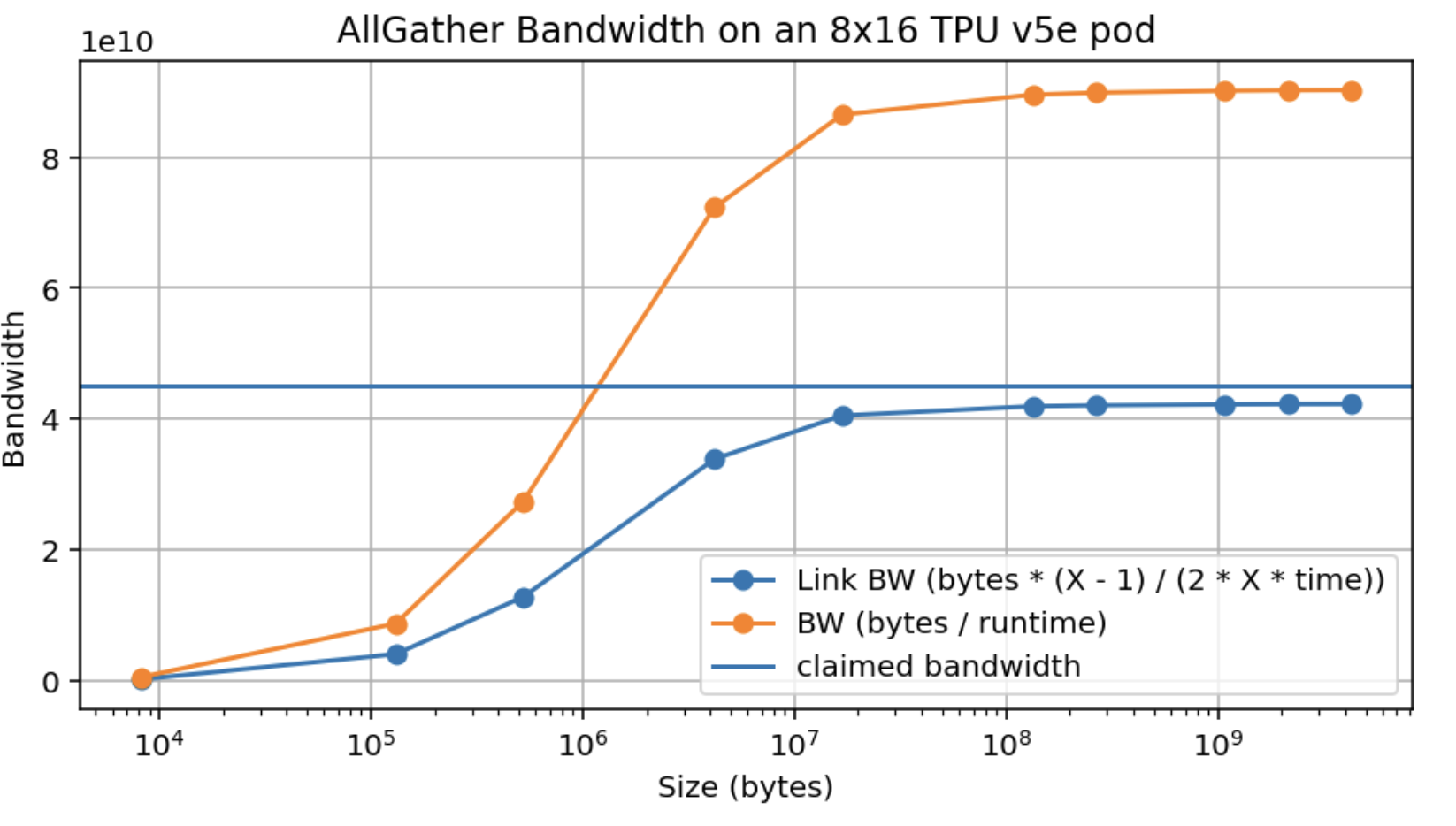
주장된 최대 대역폭(4.5e10)의 약 95%만 달성하고, 이 최대치를 약 10MB에서만 달성한다는 점에 유의하세요. 16방향으로 샤딩되면 디바이스당 약 500kB가 됩니다.
여러 축에 걸쳐 AllGather를 수행하면 어떻게 될까요? 여러 축에 걸쳐 수집할 때, 우리는 수집을 수행할 여러 차원의 ICI를 가집니다. 예를 들어, AllGatherXY([B, DXY])는 두 개의 하드웨어 메시 축에 걸쳐 작동합니다. 이는 사용 가능한 대역폭을 \(n_\text{axes}\) 배만큼 증가시킵니다.
자세한 내용은 여기를 클릭하세요.
일반적으로 우리는
\[T_{total} = \max \left[ \frac{T_{min} \cdot \sum_{i} |X_i|}{2}, \frac{V}{W_\text{ici} \cdot n_\text{axes}} \right]\]를 가집니다. 여기서 \(\sum_i \lvert X_i \rvert / 2\)는 TPU 메시에서 가장 긴 경로의 길이입니다.
Pop Quiz 2 [AllGather time]: 파트 2의 수치를 사용하여, 2D 메시 {'X': 8, 'Y': 4}를 가진 TPUv5e에서 \(E = 2048\), \(F = 8192\)인 bfloat16의 AllGatherY([EY, F]) → [E, F]를 수행하는 데 얼마나 걸릴까요? \(E=256, F=256\)일 때는 어떨까요?
답을 보려면 여기를 클릭하세요.
Answer: 몇 가지 기본 수를 계산하는 것으로 시작하겠습니다:
1) TPU v5e는 2개의 각 축에 대해 초당 4.5e10 바이트의 단방향 ICI 대역폭을 가집니다. 2) (a)의 bfloat16에서, 우리는 $A[E_Y, F]$를 가지므로 각 디바이스는 bfloat16[512, 8192] 형태의 배열을 보유하며, 이는 512 * 8192 * 2 = 8.4MB의 크기를 가집니다. 전체 배열의 크기는 2048 * 8192 * 2 = 34MB입니다.
파트 (1)의 경우, 위 공식을 사용할 수 있습니다. 한 축에 대해서만 AllGather를 수행하므로, $T_{\text{comms}} = 34e6 / 9e10 = 377\mu s$입니다. latency bound인지 확인하기 위해, 크기 4의 축에서는 최대 3개의 홉이 있으므로 지연 시간 한계는 약 3us 정도이므로 근접하지 않습니다. 하지만 TPU v5e는 한 축의 크기가 16일 때만 랩어라운드 연결을 가지므로, 여기서는 실제로 완전한 양방향 AllGather를 할 수 없습니다. 가장자리에서 다른 가장자리로 데이터가 도달하려면 3개의 홉이 필요하므로, 이론적으로는 $T_{\text{comms}} = 3 * 8.4e6 / 4.5e10 = 560\mu s$에 가깝습니다. 이 Colab의 실제 프로파일 은 $680 \mu s$를 보여주는데, 이는 이론적 대역폭의 100%를 얻지 못할 가능성이 높기 때문에 합리적입니다! 파트 (2)의 경우 각 샤드의 크기는 64 * 256 * 2 = 32kB입니다. 32e3 / 4.5e10 = 0.7us이므로, 우리는 latency bound입니다. 3개의 홉이 있으므로, 대략 3 * 1us = 3us가 걸릴 것입니다. 실제로는 8us에 가깝습니다.
Case 3: 두 피연산자 모두 축소 차원이 분할된 경우
세 번째 기본 경우는 두 피연산자 모두 동일한 메시 축을 따라 축소 차원에 샤딩된 경우입니다:
\[\textbf{A}[I, J_X] \cdot \textbf{B}[J_X, K] \rightarrow C[I, K]\]이 경우, 로컬 분할된 블록 행렬 곱셈은 동일한 축소 인덱스 집합을 공유하므로 최소한 수행이 가능합니다. 하지만 각 곱은 원하는 전체 곱의 부분 합만을 나타낼 것이며, X 차원을 따르는 각 디바이스는 이 최종 원하는 곱의 다른 부분 합을 가지게 될 것입니다. 이는 매우 흔한 경우이므로, 이 조건을 명시적으로 표시하기 위해 표기법을 확장합니다:
\[\textbf{A}[I, J_X] \cdot_\text{LOCAL} \textbf{B}[J_X, K] \rightarrow C[I, K] \{\ U_X \}\]{ U<sub>X</sub> } 표기법은 “X 메시 축에 대해 축소되지 않음(unreduced)“으로 읽으며, 연산이 최종 합산이 보류된 채 “미완성” 상태임을 의미합니다. $\cdot_\text{LOCAL}$ 구문은 로컬 합계를 수행하지만 결과를 축소되지 않은 상태로 남겨둔다는 것을 의미합니다.
이는 행렬 곱셈과 외적(outer product)에 대한 다음 결과로 볼 수 있습니다:
\[A \cdot B = \sum_{i=1}^{P} \underbrace{A_{:,i} \otimes B_{i,:}}_{\in \mathbb{R}^{n \times m}}\]여기서 ⊗는 외적(outer product)입니다. 따라서, 축 X의 TPU i가 A의 i번째 열과 B의 i번째 행을 가지고 있다면, 로컬 행렬 곱셈을 수행하여 \(A_{:,i} \otimes B_{i,:} \in \mathbb{R}_{n\times m}\)을 얻을 수 있습니다. 이 행렬의 각 항목에는 A • B가 해당 항목에서 가지는 합의 i번째 항이 포함됩니다. 전체 A • B를 얻으려면 메시 축 X에 걸쳐 샤딩한 P에 대해 여전히 합산을 수행해야 합니다. 이는 A와 B를 블록(즉, 샤드)으로 쓰고 결과의 각 샤드에 대해 합산하는 것과 동일한 방식으로 작동합니다.
이를 완화하기 위해 X 축에 걸쳐 전체 AllReduce를 사용하여 이 합산을 수행할 수 있습니다:
\[\begin{align*} A[I, J_X] \cdot_\text{LOCAL} B[J_X, K] \rightarrow &\ C[I, K] \{ U_X \} \\ \textbf{AllReduce}_X C[I, K] \{ U_X \} \rightarrow &\ C[I, K] \end{align*}\]AllReduce는 부분 합(partial sums)을 제거하여, 축을 따르는 각 디바이스가 동일한 완전히 합산된 값(fully-summed value)을 갖게 합니다. AllReduce는 이 섹션에서 논의할 몇 가지 핵심 통신 중 두 번째이며, 첫 번째는 AllGather, 다른 것들은 ReduceScatter와 AllToAll입니다. AllReduce는 축소되지 않은(부분적으로 합산된) 축을 가진 배열을 가져와 해당 축 주위로 샤드를 전달하고 결과를 누적하여 합산을 수행합니다. 시그니처는 다음과 같습니다.
\[\textbf{AllReduce}_Y A[I_X, J] \{U_Y\} \rightarrow A[I_X, J]\]이는 단순히 $\{U_Y\}$ 접미사를 제거하지만 그 외에는 결과를 변경하지 않음을 의미합니다.
AllReduce는 얼마나 비쌀까요? AllReduce가 어떻게 수행되는지에 대한 한 가지 멘탈 모델은 모든 디바이스가 자신의 샤드를 이웃에게 보내고, 받는 모든 샤드를 합산하는 것입니다. 분명히, 각 “샤드”가 전체 배열과 동일한 형태를 가지기 때문에 이는 AllGather보다 더 비쌉니다. 일반적으로, AllReduce는 AllGather보다 두 배 비쌉니다. 이를 확인하는 한 가지 방법은 AllReduce가 다른 두 가지 기본 연산(primitives), 즉 ReduceScatter와 AllGather의 합성으로 표현될 수 있다는 점을 주목하는 것입니다. AllReduce와 마찬가지로, ReduceScatter는 배열의 부분 합을 해결하지만 주어진 차원을 따라 ‘흩뿌려진(scattered)’ 또는 분할된 출력을 생성합니다. AllGather는 이 모든 조각을 모아 해당 물리적 축을 따라 논리적 축을 ‘unpartitions/unshards/replicates’합니다.
\[\begin{align*} \textbf{ReduceScatter}_{Y,J} : A[I_X,J] \{U_Y\} \rightarrow &\ A[I_X, J_Y] \\ \textbf{AllGather}_Y : A[I_X, J_Y] \rightarrow &\ A[I_X, J] \end{align*}\]ReduceScatter는 어떨까요? AllReduce가 아래 첨자를 제거하는 것처럼($F_Y \to F$ above), ReduceScatter는 축소되지 않은/부분적으로 합산된 배열을 합산한 다음 동일한 메시 축을 따라 다른 논리적 축을 흩뿌립니다(샤딩합니다). $[F]\{U_Y\} \to [F_Y]$. 애니메이션은 이것이 어떻게 수행되는지 보여줍니다: 이는 AllGather와 매우 유사하지만 각 샤드를 유지하는 대신 합산한다는 점에 유의하세요. 따라서, 축소(reduction)를 수행하는 데 걸리는 시간을 제외하면 그 지연 시간(latency)은 거의 동일합니다.

각 홉의 통신 시간은 AllGather와 마찬가지로 샤드당 바이트 수 $V / Y$를 대역폭 $W_\text{ici}$로 나눈 것이므로, 다음과 같습니다.
\[T_{\text{comms per AllGather or ReduceScatter}} = \frac{V}{W_\text{ici}}\] \[T_{\text{comms per AllReduce}} = 2 \cdot \frac{V}{W_\text{ici}}\]여기서 \(W_\text{ici}\)는 우리가 축소할 완전한 링을 가지고 있는 한 양방향 대역폭입니다.
Case 4: 두 피연산자 모두 축소되지 않는 차원이 동일한 축을 따라 분할된 경우
각 메시 차원은 텐서를 샤딩할 때 최대 한 번만 나타날 수 있습니다. 위 규칙을 수행하다 보면 이 규칙이 위반되는 상황이 발생할 수 있습니다. 예를 들면 다음과 같습니다.
\[A[I_X, J] \cdot B[J, K_X] \rightarrow C[I_X, K_X]\]이는 유효하지 않습니다. 왜냐하면 차원 X를 따르는 특정 샤드, 예를 들어 i는 C의 (i, i)번째 샤드, 즉 대각선 항목(diagonal entry)을 가질 것이기 때문입니다. 그러면 모든 샤드 중에서 결과의 대각선 항목 외에는 복구할 정보가 충분하지 않으므로 이 샤딩을 허용할 수 없습니다.
이를 해결하는 방법은 일부 차원을 AllGather하는 것입니다. 여기에는 두 가지 선택지가 있습니다:
\[\begin{align*} \textbf{AllGather}_X A[I_X, J] \rightarrow &\ A[I, J] \\ A[I, J] \cdot B[J, K_X] \rightarrow &\ C[I, K_X] \end{align*}\]또는
\[\begin{align*} \textbf{AllGather}_X B[J, K_X] \rightarrow &\ B[J, K] \\ A[I_X, J] \cdot B[J, K] \rightarrow &\ C[I_X, K] \end{align*}\]어느 경우든, 결과는 그 형태에서 X를 한 번만 언급할 것입니다. 어느 것을 선택할지는 다음 연산에 필요한 샤딩에 따라 결정됩니다.
A Deeper Dive into TPU Communication Primitives
이전의 4가지 사례는 분할된 행렬 곱셈을 수행하는 데 사용되는 몇 가지 “핵심 통신 기본 연산(core communication primitives)”을 소개했습니다:
- AllGather: 샤딩에서 아래 첨자(subscript)를 제거하여 샤드를 수집합니다.
- ReduceScatter: “축소되지 않은(un-reduced)” 접미사를 가진 배열을 해당 축에 대해 샤드를 합산하여 제거하고, 배열을 두 번째 축에 걸쳐 샤딩된 상태로 둡니다.
- AllReduce: “축소되지 않은(un-reduced)” 접미사를 제거하여, 해당 축에 대해 배열을 샤딩되지 않은 상태로 둡니다.
Mixture of Experts(MoE) 모델 및 기타 계산의 경우에 발생하는 또 다른 핵심 통신 기본 연산이 있습니다: AllToAll.
Our final communication primitive: the AllToAll
분할된 행렬 곱셈을 고려할 때 자연스럽게 떠오르지는 않지만 실제로는 끊임없이 나타나는, 마지막 기본 집합 연산은 AllToAll 집합 연산, 또는 더 정확하게는 샤딩된 전치(sharded transposition) 또는 리샤딩 연산의 특수한 경우입니다. 예:
\[\textbf{AllToAll}_{X, J} A[I_X, J] \rightarrow A[I, J_X]\]AllToAll은 호환되지 않는 레이아웃 체계를 가진 분할된 계산의 다른 영역 간에 분할된 레이아웃을 재정렬하는 데 일반적으로 필요합니다. 이는 분할된 전문가 혼합 모델을 고려할 때 자연스럽게 발생합니다. AllToAll을 한 축에서 다른 축으로 아래 첨자(subscript)를 이동하는 것으로 생각할 수 있습니다. AllToAll은 각 샤드의 모든 데이터를 링 전체에 복제할 필요가 없기 때문에 실제로는 AllGather보다 저렴합니다 (¼배)

위에서 언급했듯이, $V$ 바이트 배열의 전체 비용은 다음과 같습니다.
\[T_\text{comms per AllToAll} = \frac{V}{4 \cdot W_\text{ici}}\]여기서 평소와 같이 $W_\text{ici}$는 양방향 ICI 대역폭입니다. 이는 AllGather 비용의 1/4이고 AllReduce 비용의 1/8입니다.
More about the ReduceScatter
ReduceScatter는 보이는 것보다 더 중추적이고 근본적인 연산입니다. 왜냐하면 실제로는 AllGather의 미분(derivative)이며, 그 반대도 마찬가지이기 때문입니다. 즉, 순방향 패스에서 다음과 같다면:
\[\textbf{AllGather}_X A[I_X] \rightarrow A[I]\]그러면 역방향 모드 미분 A’(일반적으로 각 샤드에서 다를 것임)을 ReduceScatter하여 샤딩된 A’를 도출합니다:
\[\textbf{ReduceScatter}_X A'[I] \{ U_X \} \rightarrow A'[I_X]\]마찬가지로, 순방향 패스에서 \(\text{ReduceScatter}_X(A[I] \{U_X\}) \to A[I_X])\)는 역방향 패스에서 \(\text{AllGather}_{X}(A'[I_X]) \to A'[I]\)를 의미합니다.
AllReduce를 AllGather와 ReduceScatter로 바꾸는 것은 최종 AllGather를 나중의 어느 순간으로 연기(defer)할 수 있다는 편리한 속성도 가지고 있습니다. 매우 흔하게 우리는 전체 행렬 곱을 디바이스에 걸쳐 복제하여 재조립하는 비용을 지불하고 싶지 않습니다. 오히려 우리는 축소 차원이 샤딩된 두 피연산자를 결합하는 이 경우에도 샤딩된 상태를 보존하고 싶습니다:
\[A[I, J_X] \cdot B[J_X, K] \rightarrow C[I, K_X]\]이 경우, AllReduce 대신 ReduceScatter를 수행한 다음, 선택적으로 나중에 AllGather를 수행할 수 있습니다. 즉,
\[\begin{align*} A[I, J_X] \cdot_{LOCAL} B[J_X, K] \rightarrow &\ C[I, K] \{ U_X \} \\ \textbf{ReduceScatter}_{X,K} C[I, K] \{ U_X \} \rightarrow &\ C[I, K_X] \end{align*}\]ReduceScatter는 샤딩된 차원을 도입하므로, 이 경우 I 또는 K 이름 있는 차원을 따라 샤딩할 자연스러운 자유를 가집니다. 일반적으로 ReduceScatter를 사용할 때 새로운 샤딩을 도입할 어떤 이름 있는 차원을 선택해야 합니다(선택은 보통 더 큰 모델링 컨텍스트에 의해 강제되지만). 이것이 우리가 샤딩할 축을 지정하기 위해 ReduceScatterX,K 구문을 사용하는 이유입니다.
What Have We Learned?
- 배열의 샤딩은 TPU 메시의 물리적, 하드웨어 축에 이름을 지정하는 Mesh(메시)와 배열의 논리적 축에 메시 축 이름을 할당하는 Sharding(샤딩)에 의해 지정됩니다.
- 예를 들어, A[IXY, J]는 첫 번째 차원이 두 메시 축 X와 Y에 걸쳐 샤딩된 추상 배열 A를 설명합니다. 이는 Mesh(mesh_shape=(4, 8), axis_names=(‘X’, ‘Y’)) 또는 축약된 Mesh({‘X’: 4, ‘Y’: 8})와 결합되어, 우리 배열이 첫 번째 차원을 따라 32방향으로 샤딩되었음을 알려줍니다.
-
분할된 배열을 사용한 산술 연산은 샤딩된 축을 따라 축소를 수행하지 않는 한 샤딩되지 않은 배열과 똑같이 작동합니다. 그 경우, 우리는 통신을 조금은 도입해야 합니다. 우리는 네 가지 경우를 고려합니다:
- 두 배열 모두 축소 차원을 따라 샤딩되지 않은 경우: 통신이 필요 없습니다.
- 한 배열이 축소 차원을 따라 샤딩된 경우(또는 축소 차원이 다른 축을 따라 샤딩된 경우): 연산을 수행하기 전에 입력 중 하나를 AllGather합니다.
- 두 배열 모두 축소 차원을 따라 동일하게 샤딩된 경우: 샤드를 로컬에서 곱한 다음 AllReduce 또는 ReduceScatter를 수행합니다.
- 두 배열 모두 축소되지 않는 차원이 동일한 메시 축을 따라 샤딩된 경우: 입력 중 하나를 먼저 AllGather합니다.
- TPU는 대략 4가지 핵심 통신 기본 연산을 사용합니다:
- AllGather: $[A_X, B] \to [A, B]$
- ReduceScatter: $[A, B] \{U_X\} \to [A, B_X]$
- AllToAll: $[A, B_X] \to [A_X, B]$
- AllReduce: $[A_X, B]\{U_Y\} \to [A_X, B]$ (기술적으로 ReduceScatter + AllGather를 결합하므로 기본 연산은 아님)

- 이러한 각 연산의 비용과 지연 시간은 축의 크기에 의존하지 않으며(bandwidth bound인 한), 입력 배열의 크기와 링크의 대역폭에만 의존합니다. 단방향 AllGather/ReduceScatter의 경우:
- AllReduce는 ReduceScatter 다음에 AllGather로 구성되므로 위 비용의 2배입니다. AllToAll은 링 주위로 샤드를 부분적으로만 전달하면 되므로 AllGather 비용의 ¼입니다. 아래는 요약입니다:
| Operation | Description | Syntax | Runtime |
|---|---|---|---|
| AllGather | 샤딩된 배열의 모든 샤드를 한 축을 따라 모아 아래 첨자(subscript)를 제거합니다. | $[A_X, B] \to [A, B]$ | bytes / (bidirectional ICI bandwidth * num_axes) |
| ReduceScatter | 부분적으로 합산된 배열을 한 축을 따라 합산하고 다른 축을 따라 샤딩합니다(subscript 추가). | $[A, B] \{U_X\} \to [A_X, B]$ | Same as AllGather |
| AllReduce | 부분적으로 합산된 배열을 한 축을 따라 합산합니다. { Ux }를 제거합니다. AllGather와 ReduceScatter를 결합합니다. | $[A_X, B]\{U_Y\} \to [A_X, B]$ | 2 * AllGather |
| AllToAll | 한 축을 모으고(Gathers)(replicates(복제)) 동일한 축을 따라 다른 차원을 샤딩합니다. | $[A, B_X] \to [A_X, B]$ | AllGather / 4 for a bidirectional ring |
Some Problems to Work
이 섹션의 내용을 바탕으로 한 몇 가지 재밌는 문제입니다. 현재 모든 답을 포함하지는 않지만, 가능한 한 더 많은 답을 작성할 예정입니다. [역자주: 문제는 모든 챕터의 내용 번역 후 번역 예정입니다!]
Question 1 [replicated sharding]: An array is sharded $A[I_X, J, K, \ldots]$ (i.e., only sharded across $X$), with a mesh Mesh({'X': 4, 'Y': 8, 'Z': 2}). What is the ratio of the total number of bytes taken up by $A$ across all chips to the size of one copy of the array?
답을 보려면 여기를 클릭하세요.
Our array is only sharded along X, which has size 4, so effectively each shard has size $[I / 4, J, K, \ldots] = \text{sizeof}(A) / 4$. Since our array is replicated across Y and Z, the total size is $Y \cdot Z \cdot \text{sizeof}(A)$, so the ratio of total size to single chip size is $Y \cdot Z \cdot \text{sizeof}(A) / \text{sizeof}(A) = 16$.
Question 2 [AllGather latency]: How long should $\text{AllGather}_X([B_X, D_Y])$ take on a TPUv4p 4x4x4 slice with mesh Mesh({'X': 4, 'Y': 4, 'Z': 4}) if $B=1024$ and $D=4096$ in bfloat16? How about \(\text{AllGather}_{XY}([B_X, D_Y])\)? How about \(\text{AllReduce}_Z([B_X, D_Y] \{U_Z \})\)?
답을 보려면 여기를 클릭하세요.
We have a wraparound link on all axes because we have a full 4x4x4 cube, so we have 9e10 bidirectional bandwidth to work with.
-
Because we’re just gathering over one axis and the other is sharded, we’re effectively gathering $2BD / Y$ bytes over 1 axis. Since our ICI bandwidth for TPU v4p is 9e10 bytes/second bidirectional, this will take $2BD / (9e10 \cdot Y) = 2 \cdot 1024 \cdot 4096 / (9e10 \cdot 4) = 23 \mu s$.
-
We have twice the bandwidth as before but we’re AllGathering the full array, so
T = 2BD / (2 * W) = 2*1024*4096 / (2 * 9e10) = 46us. This is far from the latency bound of 4us (1us per hop), so we’re fine. -
The cost of an AllReduce is twice that of an AllGather. Each shard has size $2BD / (X * Y)$, so the cost is about $4BD / (X * Y * W)$, or roughly
4 * 1024 * 4096 / (16 * 9e10) = 11.6us.
Question 3 [latency-bound AllGather]: Let’s say we’re performing an $\text{AllGather}_X([B_X])$ but $B$ is very small (say 128). How long should this take on a TPUv4p 4x4x4 slice with mesh Mesh({'X': 4, 'Y': 4, 'Z': 4}) in bfloat16? Hint: you’re probably latency bound.
답을 보려면 여기를 클릭하세요.
Our array in bfloat16 uses only 256 bytes total, and only 64 per device. Since we have an axis of size 4 on a TPU v4p, we have a wraparound link, so we can send the array in both directions. With 4.5e10 of unidirectional bandwidth, each hop would take roughly 64 / 4.5e10 ~ 0, so we’re definitely latency bound. Counting the number of hops, we can do the full gather in only 2 hops, so roughly 2us a good estimate.
Question 4 [matmul strategies]: To perform $X[B, D] \cdot_D Y[D_X, F] \to Z[B, F]$, in this section we tell you to perform $\text{AllGather}_X(Y[D_X, F])$ and multiply the fully replicated matrices (Case 2, Strategy 1). Instead, you could multiply the local shards like $X[B, D_X] \cdot_D Y[D_X, F] \to Z[B, F] \{U_X\}$ (Case 4, Strategy 2), and then $\text{AllReduce}_X(Z[B, F] \{ U_X\})$. How many FLOPs and comms does each of these perform? Which is better and why?
답을 보려면 여기를 클릭하세요.
Let’s start with our baseline (Strategy 1). As we’ve shown, the cost of the AllGather is $2DF / W_\text{ici}$. Once we have the fully replicated arrays, the total compute time is $2BDF / C$ (where $C$ is our accelerator FLOPs/s, since each TPU does the same FLOPs). So we have
\[T_\text{total (Strategy 1)} = \max\left(\frac{2BDF}{C}, \frac{2DF}{W_\text{ici}}\right)\]By comparison, the new strategy (Strategy 2) does an AllReduce over $2BF$ bytes, which has cost $4BF / W_\text{ici}$ but does $1 / X$ fewer FLOPs (since the computation is sharded). This means we do $2\cdot B\cdot D\cdot F / X$ FLOPs and the resulting AllReduce communicates \(2 \cdot 2 \cdot B \cdot F\) bytes in bfloat16. Thus, our total time for Strategy 2 (no AllGather, just an AllReduce later on) is roughly
\[T_\text{total} = \max\left(\frac{2BDF}{X \cdot C}, \frac{4BF}{W_\text{ici}}\right)\]The question is: which of these is bigger? Strategy (2) is compute bound when $D / (X \cdot C) > 2 / W_\text{ici}$, or when $D / 2X > C / W_\text{ici} \approx 2550 \rightarrow X < D / (2 * 2550)$. We might reasonably expect $D \approx 8k$, so this would mean roughly $X < 2$ which is unlikely – hence we’re basically always comms bound with Strategy 2. With the baseline (Strategy 1), we’re comms bound when \(B < C / W_\text{ici} = 2550\) which is often but not always true.
So if $B < 2550$, we’re comms-bound in both cases and we have
\[T_\text{comms for Strategy 2} < T_\text{comms for Strategy 1} \Leftrightarrow \frac{4BF}{W_\text{ici}} < \frac{2DF}{W_\text{ici}}\]which is true when $D > 2B$ where $2B < 5100$. This is often true, so Strategy 2 can sometimes be better if our batch is small. When our batch is large ($B > 2550$), we have
\[T_\text{comms for Strategy 2} < T_\text{math for Strategy 1} \Leftrightarrow \frac{4BF}{W_\text{ici}} < \frac{2BDF}{C}\]This is true when $2 / W_\text{ici} < D / C$, or when $D > 2 * 2550 = 5100$, which is usually true for large models. So this alternative strategy is typically better for large models, unless $D$ is small.
Why don’t we always do this? Well, in practice we may do this sometimes, but it’s typically rare to have the contracting dimension of one of the inputs to a matmul sharded along a axis that the other input isn’t sharded over. For instance, if we’re doing FSDP (explained in Section 5), we’ll shard our parameters over the data dimension but our activations will also be sharded along data. So in this sense this doesn’t show up much.
Question 5 [minimum latency]: Let’s say I want to do a matmul $A[B, D] \cdot_D B[D, F] \to C[B, F]$ on a TPUv5p 4x4x4 with the lowest possible latency. How should my inputs be sharded? What is the total FLOPs and comms time?
Question 6: Let’s say we want to perform $A[I_X, J_Y] \cdot_J B[J_Y, K] \to C[I_X, K]$ on TPUv5e 4x4. What communication do we perform? How much time is spent on communication vs. computation?
- What about $A[I_X, J] \cdot_J B[J_X, K_Y] \to C[I_X, K_Y]$? This is the most standard setting for training where we combine data, tensor, and zero sharding.
- What about $A[I_X, J] \cdot_J B[J, K_Y] \to C[I_X, K_Y]$? This is standard for inference, where do pure tensor parallelism (+data).
Question 7: A typical Transformer block has two matrices $B[D, F]$ and $C[F, D]$ where $F \gg D$. With a batch size B, the whole block is \(C \cdot B \cdot x\) with \(x[B, D]\). Let’s pick \(D=8192\), \(F=32768\), and \(B=128\) and assume everything is in bfloat16. Assume we’re running on a TPUv5e 2x2 slice but assume each TPU only has 300MB of free memory. How should B, C, and the output be sharded to stay below the memory limit while minimizing overall time? How much time is spent on comms and FLOPs?
Question 8 [challenge]: Using the short code snippet above as a template, allocate a sharded array and benchmark each of the 4 main communication primitives (AllGather, AllReduce, ReduceScatter, and AllToAll) using pmap or shard_map. You will want to use jax.lax.all_gather, jax.lax.psum, jax.lax.psum_scatter, and jax.lax.all_to_all. Do you understand the semantics of these functions? How long do they take?
Question 9 [another strategy for sharded matmuls?]: Above we claimed that when only one input to a matmul is sharded along its contracting dimension, we should AllGather the sharded matrix and perform the resulting contracting locally. Another strategy you might think of is to perform the sharded matmul and then AllReduce the result (as if both inputs were sharded along the contracting dimension), i.e. $A[I, J_X] *_J B[J, K] \to C[I, K]$ by way of
- $C[I, K] \{ U_X \} = A[I, J_X] \cdot B[J_X, K]$
- $C[I, K] = \text{AllReduce}(C[I, K] \{ U_X\})$
Answer the following:
- Explicitly write out this algorithm for matrices $A[N, M]$ and $B[M, K]$, using indices to show exactly what computation is done on what device. Assume $A$ is sharded as $A[I, J_X]$ across ND devices, and you want your output to be replicated across all devices.
- Now suppose you are ok with the final result not being replicated on each device, but instead sharded (across either the N or K dimension). How would the algorithm above change?
- Looking purely at the communication cost of the strategy above (in part (b), not (a)), how does this communication cost compare to the communication cost of the algorithm in which we first AllGather A and then do the matmul?
답을 보려면 여기를 클릭하세요.
- First compute the outer products, storing the result in \(O[N, K]: o_{kj} = \sum_i a_{ki} b_{ij}\). Note that the repeated index is not the one being contracted, as we are doing an outer product. Here the sum ranges across the set of i values stored on the particular device we are using. So, for example, if we have a contracting axis of size 16, and 4 devices, then on device 0, i would range from {0, 1, 2, 3}; on device 1, i would range from {4, 5, 6, 7}; on device 2, i would range from {8, 9, 10, 11}; and on device 3, i would range from {12, 13, 14, 15}. Then AllReduce the partial-sums of $O[N, K]$ which live on each device, to form the full $O[N, K]$.
- Instead of doing an AllReduce in step 2, we could get away with a cheaper ReduceScatter, along either axis: $[N, K] \{ U_X \} \to [N_X, K]$ or $[N, K] \{ U_X \} \to [N, K_X]$.
- As described in the main text above, the cost of doing an AllGather (when we are throughput-bound) is the same as that of a ReduceScatter; it is simply given by the size of the full matrix we are processing. So in the gather-then-matmul algorithm, this scales as $NM$ (since we are $\text{AllGather}$-ing $A$); in the matmul-then-reduce-scatter algorithm, this scales as NK (since we are reduce-scattering $O$). So the communication cost ratio of the two algorithms is
M/K.
Question 10: Fun with AllToAll: In the table above, it was noted that the time to perform an AllToAll is a factor of 4 lower than the time to perform an AllGather or ReduceScatter (in the regime where we are throughput-bound). In this problem we will see where that factor of 4 comes from, and also see how this factor would change if we only had single-direction ICI links, rather than bidirectional ICI links.
- Let’s start with the single-direction case first. Imagine we have D devices in a ring topology, and If we are doing either an AllGather or a ReduceScatter, on an N x N matrix A which is sharded as $A[I_X, J]$ (say $D$ divides $N$ for simplicity). Describe the comms involved in these two collectives, and calculate the total number of scalars (floats or ints) which are transferred across a single ICI link during the entirety of this algorithm.
- Now let’s think about an AllToAll, still in the single-directional ICI case. How is the algorithm different in this case than the all-gather case? Calculate the number of scalars that are transferred across a single ICI link in this algorithm.
- You should have found that the ratio between your answers to part (a) and part (b) is a nice number. Explain where this factor comes from in simple terms.
- Now let’s add bidirectional communication. How does this affect the total time needed in the all-gather case?
- How does adding bidirectional communication affect the total time needed in the AllToAll case?
- Now simply explain the ratio between AllGather time and AllToAll time in a bidirectional ring.
답을 보려면 여기를 클릭하세요.
(1) Solution: The process is simple: in each step of the algorithm, each device will send a single-shard “strip” of the matrix (totalling \(\frac{N}{D} \times N\) elements in size) to its nearest neighbor. This occurs \(D-1\) times, since each shard needs to be communicated to all of the devices except the one it starts out on. So in total, \(\frac{N^2(D-1)}{D}\) scalars are transferred by each device, i.e. flow across a single ICI link.
Answer: \(N^2 (1-\frac{1}{D})\), or simply \(N^2\) when \(D >> 1\).
(2) Solution: The key difference between an AllToAll and an AllGather, from the perspective of communications, is that in an AllToAll, the entirety of the shard that lives on a particular device does not need to be communicated to every other device. Imagine the shard stored on a particular device (call it device 0) is \([A, B, C, D]\) (here A,B,C,D are matrices and we are imagining a ring with 4 devices for illustration). Now the matrix \(A\) does not need to be communicated anywhere, the matrix \(B\) needs to end up on device 1; matrix \(C\) ends up on device 2; and matrix \(D\) ends up on device 3. So in the first step of the algorithm, we send \(B\), \(C\), and \(D\) to device 1; in the next step, device 1 sends \(C\) and \(D\) onwards to device 2; in the final step, device 2 sends just \(D\) on to device 3. The total number of parameters transferred in this case is \((\text{size of A/B/C/D}) * (3 + 2 + 1)\). The size of A/B/C/D is (in the general case now) \(\frac{N^2}{D^2}\), and again in the general case the \((3 + 2 + 1)\) term becomes \(((D-1) + (D-2) + … + 1)\), or \(\frac{(D)(D-1)}{2}\). So the total number of bytes transferred across a single ICI link is \(\frac{N^2(D-1)}{D \times 2}\).
Answer: \(\frac{N^2}{2}(1-\frac{1}{D})\), or simply \(\frac{N^2}{2}\) when \(D >> 1\).
(3) Solution: The factor is simply \(\frac{1}{2}\), i.e. an AllToAll is half as costly as an all-gather/ReduceScatter on a unidirectional ring topology. Looking over the derivations above, this ultimately came from the fact that in the all-gather case, we are transferring the same sized block each of \((D-1)\) times, i.e. we’re doing the sum \(\text{tiny block size} * (D + D + D + … + D)\), whereas in the AllToAll case, we’re doing the sum \(\text{tiny block size} * (D + D-1 + D-2 + … + 1)\). The factor of two thus essentially comes from the fact that \(1 + 2 + \ldots + n = n(n+1)/2\).
(4) Solution: The total number of scalars that any one link has to carry now reduces by a factor of 2, since in a bidirectional ring, each “sharded strip” can be sent two ways simultaneously.
(5) Solution: In this case, we win a factor of 4 compared to the unidirectional case. This is easiest to see by considering the fate of each of the size-(N2/D2) blocks in a single sharded strip, say the one which originates on device 0. Instead of (as in the unidirectional case) sending one of these blocks a distance of D-1, another block a distance D - 2, etc. all the way to 1, we now divide the strip into blocks which move right or left, moving a maximum distance of ceil(D/2). So the corresponding sum now becomes \(D/2 + D/2 - 1 + D/2 - 2 + … = D/2 \cdot (D/2+1)/2\), or \(D^2/8\) in the limit of large \(D\). Compare this to \(D^2/2\) in the unidirectional case, and we see that we’ve won a factor of 4.
(6) Solution: In a unidirectional ring, we saw that the AllToAll time was already twice as fast as the all-gather time; this comes from the fact that we don’t need to send our full strip to every single device. Then, when we added bidirectionality, we saw that it was a 4x win for AllToAll, and only a 2x win for all-gathers. Putting these ratios together, we get our sought after factor of 4.